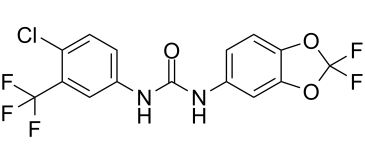Physicochemical Properties
| Molecular Formula | C15H8CLF5N2O3 |
| Molecular Weight | 394.68 |
| Exact Mass | 394.014 |
| CAS # | 2165324-62-7 |
| PubChem CID | 132190620 |
| Appearance | Typically exists as solid at room temperature |
| LogP | 4.6 |
| Hydrogen Bond Donor Count | 2 |
| Hydrogen Bond Acceptor Count | 8 |
| Rotatable Bond Count | 2 |
| Heavy Atom Count | 26 |
| Complexity | 536 |
| Defined Atom Stereocenter Count | 0 |
| InChi Key | SHPYXCLUNMOJOB-UHFFFAOYSA-N |
| InChi Code | InChI=1S/C15H8ClF5N2O3/c16-10-3-1-7(5-9(10)14(17,18)19)22-13(24)23-8-2-4-11-12(6-8)26-15(20,21)25-11/h1-6H,(H2,22,23,24) |
| Chemical Name | 1-[4-chloro-3-(trifluoromethyl)phenyl]-3-(2,2-difluoro-1,3-benzodioxol-5-yl)urea |
| Synonyms | PK-150 |
| HS Tariff Code | 2934.99.9001 |
| Storage |
Powder-20°C 3 years 4°C 2 years In solvent -80°C 6 months -20°C 1 month |
| Shipping Condition | Room temperature (This product is stable at ambient temperature for a few days during ordinary shipping and time spent in Customs) |
Biological Activity
| Targets | MSSA(MIC= 0.3 µM);MRSA(MIC= 0.3-1µM);VISA(MIC= 0.3 µM) |
| ln Vivo | Using a mouse bloodstream infection model, the in vivo effectiveness of PK150 against methicillin-sensitive S. aureus (MSSA) (strain SH1000) is shown. The liver and heart have much lower bacterial loads when treated with PK150 (20 mg/kg; p.o.).In mice, PK150 (10 and 20 mg/kg orally; or 10 mg/kg intravenously) does not manifest any overt toxicity. For later therapeutic models, higher intravenous dosages of 20 mg/kg are avoided due to their severe toxic effects[1]. |
| Animal Protocol |
Animal Model: Pathogen-free 9-week old female C57BL/6J mice[1] Dosage: 20 mg/kg Administration: Administered p.o. Result: Both the liver and the heart had markedly decreased bacterial loads, which had decreased by about 100 times. |
| References |
[1]. Repurposing human kinase inhibitors to create an antibiotic active against drug-resistant Staphylococcus aureus, persisters and biofilms. Nat Chem. 2019 Dec 16. |
Solubility Data
| Solubility (In Vitro) | DMSO : ~250 mg/mL (~633.42 mM) |
| Solubility (In Vivo) |
Solubility in Formulation 1: ≥ 2.08 mg/mL (5.27 mM) (saturation unknown) in 10% DMSO + 40% PEG300 + 5% Tween80 + 45% Saline (add these co-solvents sequentially from left to right, and one by one), clear solution. For example, if 1 mL of working solution is to be prepared, you can add 100 μL of 20.8 mg/mL clear DMSO stock solution to 400 μL PEG300 and mix evenly; then add 50 μL Tween-80 to the above solution and mix evenly; then add 450 μL normal saline to adjust the volume to 1 mL. Preparation of saline: Dissolve 0.9 g of sodium chloride in 100 mL ddH₂ O to obtain a clear solution. Solubility in Formulation 2: ≥ 2.08 mg/mL (5.27 mM) (saturation unknown) in 10% DMSO + 90% Corn Oil (add these co-solvents sequentially from left to right, and one by one), clear solution. For example, if 1 mL of working solution is to be prepared, you can add 100 μL of 20.8 mg/mL clear DMSO stock solution to 900 μL of corn oil and mix evenly. (Please use freshly prepared in vivo formulations for optimal results.) |
| Preparing Stock Solutions | 1 mg | 5 mg | 10 mg | |
| 1 mM | 2.5337 mL | 12.6685 mL | 25.3370 mL | |
| 5 mM | 0.5067 mL | 2.5337 mL | 5.0674 mL | |
| 10 mM | 0.2534 mL | 1.2668 mL | 2.5337 mL |
